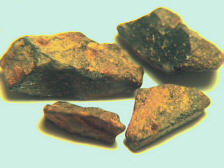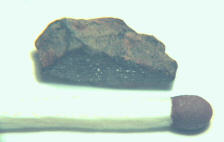

Glenrothes
The Glenrothes (pronounced Glen-roth-ees)
chondrite is the first ever meteorite find on UK soil.....I say
"first", because the Danebury meteorite of Hampshire,
England, was discovered in an Iron Age pit, and was obviously an
observed/witnessed fall that was deliberately placed there, as
some kind of wonderous relic.
I was lucky enough to have made the Glenrothes discovery during
the Summer of 1998 - the full story is in the September/October
1999 edition of Voyage! magazine.
Several small fragments were found in relative close proximity to
each other and are probably part of a small though larger stone
that has broken apart and fragmented during many years of freeze/thaw
exposure to the UK's cold & damp weather. The total known
weight of this find is 14.8g (comprised of many small fragments)
with the main mass just 1.1g - no more fragments have been found
during recent visits to the locality and the site has almost
certainly yielded all of the fragments that can practically be
recovered.
This meteorite has now been formally classified by Dr.Monica
Grady of the Natural History Museum, London and Arabelle Sexton
of the Open University, Milton Keynes where the olivine and
oxygen values were found to be right on the edge of the H-group
field. Mean olivine compostion is Fa21.4, towards L-group values.
It is shock stage S3 and weathering grade W4. The oxygen isotopic
composition proved to be slightly out of the main H-group field,
towards the terrestrial fractionation line but was considered to
be a result of terrestrial weathering.
The consensus is that Glenrothes is an H5 chondrite and the full
analysis and report was forwarded to the Nomenclature Committe of
the Meteoritical Society who have now approved the Glenrothes
name and classification......this will appear in the June 2000
issue of the Meteoritical Bulletin.
To my knowledge, very few people have tried their hand at
meteorite hunting in the UK because our wet climate is considered
very hostile for the preservation of meteorites, though the
Glenrothes find at least proves that it can be possible to
discover new "old" meteorites in the British Isles,
albeit as small weathered fragments.
 Small sub-gram
fragments in the order of 0.3 - 0.5g each, weathered externally
and with a powdery rusty crust.
Small sub-gram
fragments in the order of 0.3 - 0.5g each, weathered externally
and with a powdery rusty crust.
 Small
fragment with cut face beside a matchstick for scale.
Small
fragment with cut face beside a matchstick for scale.
 Close-up of
the fragment pictured above.
Close-up of
the fragment pictured above.

Fernlea, The
Wynd, Milton of Balgonie, Fife. KY7 6PY United Kingdom
Please
- no requests to authenticate old rock and stone finds
I've heard the
"My grandad saw it fall in a field and gave it to me!"
story (and all variations) a zillion times
Telephone: 07880-888660
Email: fernlea4@aol.com
© Rob Elliott